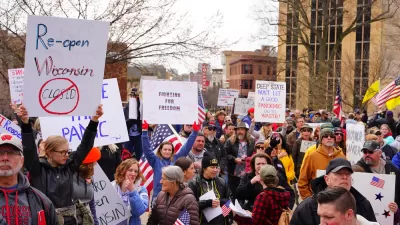During the pandemic's first phase in March and April, the Northeast was devastated by COVID-19. After Memorial Day, the surge was in the South and West. As cases decrease nationwide, they are now spiking in the Midwest, particularly North Dakota.

"Novel coronavirus infections are trending upward across the Midwest, raising concerns that those states are struggling to contain their outbreaks even as the nation’s total daily caseload continues to decline," reported and
highest increase in daily reported cases per capita over the last week, 46 percent, based on on a seven-day rolling average of daily new reported cases per 100,000 residents, followed by South Dakota with a 42 percent increase. (See below emboldened header for more specific information on the outbreak in the International Peace Garden State.)
"A dramatic increase in North Dakota's coronavirus cases showed signs of stabilizing on Monday, Aug. 24, capping the worst week for new cases since the start of the pandemic," reported Adam Willis for the Grand Forks Herald, though that turned out not to be the case as the aforementioned Washington Post tracker indicated on Tuesday. Like his counterparts at The Washington Post, Willis noted the downward trend of new infections nationwide, and more importantly, what caused it.
Nationally, new case reports are in decline, a trend that health experts have attributed to local mask mandates and business closures in some of the most affected areas.
Harvard's COVID Risk Levels Dashboard indicated on Aug. 25 that North Dakota trailed only Mississippi in having the highest coronavirus case incidence, with 24.2 cases per 100,000 people (seven-day moving average), but that is based on Aug. 23 data. The dashboard does not include U.S. territories. Guam shows 36 new daily reported cases per 100,000 people, a 176 percent increase in the last week based on Aug. 25 data, according to The Washington Post tracker. North Dakota had the third-highest daily reported cases per capita, 28 per 100,000, after Guam and Mississippi with 29 per 100,000.
Return of college students increases community spread
"Increased case counts in Grand Forks and Cass County have come as students at the University of North Dakota, in Grand Forks, and the North Dakota State University, in Fargo, return to campus for the fall semester," added Willis. A Grand Forks public health official "said upwards of about 75% of the recent spate of new cases are the result of UND students returning to campus," reported the Herald on Aug. 25. "Students were not required to get tested prior to arriving on campus, nor once they arrived on campus."
Hat tips to Angela Fritz and Avi Selk, authors of The Washington Post Coronavirus Updates newsletter.
Related in Planetizen:
-
COVID's New Demographic, June 29, 2020
FULL STORY: Coronavirus update: Infections are trending upward in the Midwest

Maui's Vacation Rental Debate Turns Ugly
Verbal attacks, misinformation campaigns and fistfights plague a high-stakes debate to convert thousands of vacation rentals into long-term housing.

Planetizen Federal Action Tracker
A weekly monitor of how Trump’s orders and actions are impacting planners and planning in America.

In Urban Planning, AI Prompting Could be the New Design Thinking
Creativity has long been key to great urban design. What if we see AI as our new creative partner?

King County Supportive Housing Program Offers Hope for Unhoused Residents
The county is taking a ‘Housing First’ approach that prioritizes getting people into housing, then offering wraparound supportive services.

Researchers Use AI to Get Clearer Picture of US Housing
Analysts are using artificial intelligence to supercharge their research by allowing them to comb through data faster. Though these AI tools can be error prone, they save time and housing researchers are optimistic about the future.

Making Shared Micromobility More Inclusive
Cities and shared mobility system operators can do more to include people with disabilities in planning and operations, per a new report.
Urban Design for Planners 1: Software Tools
This six-course series explores essential urban design concepts using open source software and equips planners with the tools they need to participate fully in the urban design process.
Planning for Universal Design
Learn the tools for implementing Universal Design in planning regulations.
planning NEXT
Appalachian Highlands Housing Partners
Mpact (founded as Rail~Volution)
City of Camden Redevelopment Agency
City of Astoria
City of Portland
City of Laramie





























